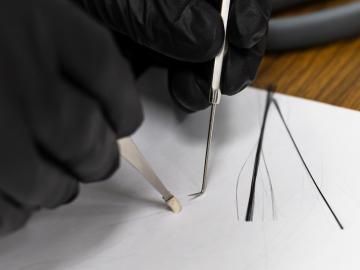
Filter News
Area of Research
- Advanced Manufacturing (2)
- Biology and Environment (37)
- Biology and Soft Matter (1)
- Computational Engineering (1)
- Computer Science (1)
- Energy Science (67)
- Energy Sciences (1)
- Fusion and Fission (7)
- Fusion Energy (7)
- Isotopes (21)
- Materials (45)
- Materials for Computing (10)
- Mathematics (1)
- National Security (13)
- Neutron Science (11)
- Nuclear Science and Technology (13)
- Nuclear Systems Modeling, Simulation and Validation (1)
- Quantum information Science (3)
- Supercomputing (49)
News Type
News Topics
- (-) Advanced Reactors (25)
- (-) Cybersecurity (17)
- (-) Energy Storage (64)
- (-) Frontier (45)
- (-) Isotopes (38)
- (-) Microscopy (34)
- (-) Nanotechnology (29)
- (-) Quantum Computing (39)
- (-) Space Exploration (23)
- 3-D Printing/Advanced Manufacturing (89)
- Artificial Intelligence (92)
- Big Data (62)
- Bioenergy (84)
- Biology (100)
- Biomedical (53)
- Biotechnology (28)
- Buildings (50)
- Chemical Sciences (48)
- Clean Water (30)
- Composites (21)
- Computer Science (153)
- Coronavirus (30)
- Critical Materials (17)
- Education (2)
- Emergency (4)
- Environment (164)
- Exascale Computing (52)
- Fossil Energy (7)
- Fusion (47)
- Grid (54)
- High-Performance Computing (93)
- Hydropower (12)
- Irradiation (2)
- ITER (7)
- Machine Learning (51)
- Materials (87)
- Materials Science (89)
- Mathematics (11)
- Mercury (10)
- Microelectronics (3)
- Molten Salt (7)
- National Security (63)
- Neutron Science (109)
- Nuclear Energy (85)
- Partnerships (37)
- Physics (38)
- Polymers (18)
- Quantum Science (58)
- Security (17)
- Simulation (51)
- Software (1)
- Statistics (3)
- Summit (48)
- Transportation (66)
Media Contacts

Stronger than steel and lighter than aluminum, carbon fiber is a staple in aerospace and high-performance vehicles — and now, scientists at ORNL have found a way to make it even stronger.

The fifth annual Quantum Science Center, or QSC, Summer School at Purdue University, held Apr. 21 through Apr. 25, 2025, welcomed its largest group of students to date. Experts from industry, academia and national laboratories gathered at the Purdue Quantum Science and Engineering Institute to share their research in multiple areas of quantum science.

Working in collaboration with researchers from Oak Ridge National Laboratory, D-Wave Quantum Inc., a quantum computing systems, software and services provider, has shown its annealing quantum computing prototype has the potential to operate faster than the leading supercomputing systems.
Mariam Kiran, a quantum research scientist at the Department of Energy’s Oak Ridge National Laboratory, was recently honored as a finalist at the British Council’s Study U.K. Alumni Awards 2025, which celebrate the achievements of U.K. alumni worldwide.
Robert “Bob” Hettich, an ORNL Corporate Fellow, is a pioneer in using mass spectrometry to uncover how microbes interact within complex environments and influence larger systems like plants and humans. A founder of the field of metaproteomics, he leads research that supports bioenergy, environmental resilience and health through advanced protein analysis.

ORNL researchers helped introduce college students to quantum computing for the first time during the 2025 Winter Classic Invitational, providing hands-on access to real quantum hardware and training future high-performance computing users through a unique challenge that bridged classical and quantum technologies.

A team from ORNL, joined by university students, recently traveled to the Ohio State University Research Reactor to conduct a novel experiment on nuclear thermal rocket fuel coatings — one that could help propel NASA’s astronauts to Mars faster and more efficiently.

Researchers from ORNL have developed a new application to increase efficiency in memory systems for high performance computing. Rather than allow data to bog down traditional memory systems in supercomputers and impact performance, the team from ORNL, along with researchers from the University of Tennessee, Knoxville, created a framework to manage data more efficiently with memory systems that employ more complex structures.

Researchers at ORNL tested a quantum computing approach to an old challenge: solving canonical fluid dynamics problems. The study relied on support from the Quantum Computing User Program, part of ORNL’s Oak Ridge Leadership Computing Facility. The results highlight avenues for further study of quantum computing’s potential to aid scientific discovery.

Researchers at Georgia State University used the Summit supercomputer to study an elaborate molecular pathway called nucleotide excision repair. Decoding NER’s sophisticated sequence of events and the role of PInC in the pathway could provide key insights into developing novel treatments and preventing conditions that lead to premature aging and certain types of cancer.


